It’s number 79 on the Periodic Table of the Elements. Such an inauspicious number for the mineral that continues to drive the masses on a never-ending search for perpetual wealth and happiness. According to some sources, its symbol, Au, is derived from the Latin aurum, meaning the “glow of sunrise” … a time filled with hope and opportunity before the incessant drone of day begins.
It’s what made California’s Mormon leader Samuel Brannan run through the streets of San Francisco in May 1848, waving a quinine bottle filled with the yellow luster yelling, “Gold! Gold! Gold from the American River!” Miners flocked to the only store at Sutter’s Fort – Brannan’s store – where they would buy his mining wares at inflated prices and help him become California’s first millionaire.
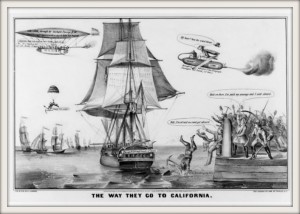
This wonderful depiction of the frenzy known as the California Gold Rush is a cartoon lithograph published by Nathaniel Currier in 1849 and entitled The Way They Go To California. The dock is crowded with men brandishing picks and shovels, some jumping from the dock to reach the departing ship. A crowded airship flies overhead, with one man parachuting down with a pick and shovel. Unbelievably for its time, a man on a rocket flies overhead. Image courtesy of the U.S. Library of Congress.
Soon, as J.S. Holliday so aptly put, the world rushed in to the tiny village of San Francisco. Throngs of emigrant landlubbers began tramping their way west by the Overland Route. Others would brave a three-month voyage around dangerous Cape Horn, or via the shorter but tropical disease-infested land-crossing at the Isthmus of Panama to catch the Pacific shipping route north to San Francisco.
Once they arrived, it seemed most who rushed in proceeded to immediately rush out to the new diggings. Hundreds of ships were abandoned and left unattended. Some would be connected to shore by long wooden piers extending into mucky Yerba Buena cove, becoming instant storefronts, hotels, and saloons. Eventually, some would be buried in the water lots where they sat, as San Francisco’s rolling landscape was leveled. Tons upon tons of rock and sand dunes would be pushed into the bay, setting the foundation for today’s Financial District and forever changing the shape of the City’s shoreline.
By foot or by ferry, gold-seekers made their way to the Sierra foothills in search of their wealth and future happiness. The majority either came away empty-handed, or barely found enough gold to make their way home. Untold numbers died, with some families never learning of their loved one’s fate.
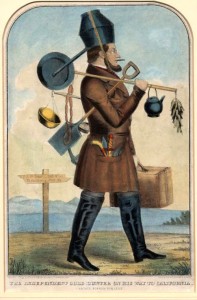
This hand tinted lithograph entitled Independent Gold Hunter on His Way to California was published by Kelloggs and Comstock of New York, and Ensign & Thayer of Buffalo, in 1850. Image available in Section V. Gold Mania Satirized, at the California State Library.
Off they went to the back hills of nowhere with only a pick, shovel, gold pan, and Lady Luck. But, did those Argonauts actually need to leave San Francisco? Could they have found their wealth right here in the City by the Bay?
EUREKA! Gold! Gold on Leavenworth!
What may be the earliest report of gold diggings in San Francisco appeared in the Sacramento Daily Union on May 21, 1855. Men grading Leavenworth street had discovered a “scale” several feet below the surface measuring 8 grains, the equivalent of 0.02 ounces. At today’s gold prices, it’s value would be about $33. The brief article notes, “The diggings then ‘guv out.”
EUREKA! Gold! Gold on Broadway!
In February 1872, quarrymen digging out rock on Broadway between Kearny and Montgomery streets made what was thought to be a valuable discovery. As described in the San Francisco Chronicle, the reporter,
“… found an eager and excited crowd. Every man, woman and child had a chunk of red rock (very valuable, for concrete), and each was busily engaged in endeavoring to detect traces of gold. One reporter found that a vein of mingled quartz and granite, about eighteen inches in width, had been laid bare, and specimens of the rock looked as though a diligent assay might possibly result in a few dollars to the ton; but we wouldn’t care to risk our hopes of future financial independence on the dividends of that mine. The lode or ‘streak’ runs in a northeasterly and southwesterly direction, and dips eastward. The lot on which it was discovered is owned by a Mrs. Cole, and the rock is being quarried by Milles & Brennan, who furnish the rock to Mr. Jordan, the concrete purveyor of the new City Hall. The superintendant of the quarry states that the discovery was first made by the workmen on Thursday afternoon, and that several cartloads of the ‘ore’ must have been hauled off and transformed into concrete before the nature of the rock was known. It is possible that further explorations may develop gold-bearing quartz that would pay for working, but chances are against it. A blast will be exploded this afternoon, which may throw more light on this subject and more rocks on neighbors’ heads.”
EUREKA! Gold! Gold in Bernal Heights!
The first land sold in Bernal Heights had been transferred by auction at the real estate offices of H.A. Cobb and R.H. Sinton, 102 Montgomery Street, on July 14, 1860. The property consisted of “4, 5, and 6 acre lots on the ‘Bernal Heights’ … within 15 minutes drive from City Hall … for sale at a very low rate … The lands, for beauty of locality, commanding scenery and fertility of soil, are not surpassed in the county of San Francisco.” In August 1865, another 66 homestead lots were offered in on the “Cobb Tract” of Bernal Heights and buyers were to receive title and a U.S. patent. In 1863, the original St. Mary’s College for boys was established on the Old Mission Road by the first archbishop of San Francisco, the Most Reverend Joseph Sadoc Alemany. The campus would move to Oakland in 1870, and in later years to Moraga where it is found today.
Yet, despite all of the homesteading, it would not be until May 1876 when the first report of an “alleged gold-bearing ledge” on Bernal Heights appeared in a small legal note in the Daily Alta California. One might suspect that the discoverer, Victor Bessayre, secretary of the Cedar Hill Consolidated Mining and Milling Company in Virginia City, Nevada (home office at 120 Sutter Street in San Francisco), had the savvy and know-how to appreciate what he had found. Soon after, a second 1500-foot location was “claimed” by Payot, Upham & Co., publishers, booksellers, and stationers in San Francisco, adjoining the northwestern edge of Bessayre’s claim.
Soon, word of the find became widespread and the masses embarked on a feverish San Franciscan Gold Rush. As told by a Daily Alta California reporter:
“Out Folsom street, over a romantic bridge which spans the creek, the ascent of Bernal Heights is begun. The grade is very steep by this route, and frequent stoppages are made in order to rest and view the landscape, which, by the way, is well worth the struggle. Soon you meet persons returning from the gold region, nearly all bearing away specimens of worthless red rock with some quartz sprinkled through it. Some shout ‘we have a sight,’ others ask ‘got a prospect?’ while others say ‘no need of going further, boys, all the claims are located.’ After half an hour of weary struggling against the wind and stones, and over the short slippery grass, the ascent of the first and smaller hill is accomplished.
“After resting a moment, an unexpected sight greets you. Fully five hundred people, consisting of men of all ages, from the very aged to the beardless youth, women gayly [sic] attired, children sporting about under the lee of the larger hill – which towers 100 feet above – engaged in various occupations. Most of the men are in possession of small hammers, and are busily engaged breaking the rocks in pieces in vain attempts to find the precious metal. The women and children are seated on the rocks, digging and pecking away, expecting a rich find. After walking around and examining a few specimens in the hands of some lucky gold-hunters, you come across some boards stuck up, resembling a real estate sign, but much smaller, on which is nailed a notice that the parties therein named have located 1500 feet, bearing from the site, in such a direction so far, and so on to place of commencement, with all the dips, spurs, etc.
“Some speculative individual, with an eye to business, has started a beer shop, consisting of a rude table, underneath which there is gracefully placed two beer kegs, and on top sundry glasses and a free lunch. A short distance down from the summit of the hill you notice our glorious standard, the ‘Star-Spangled Banner,’ floating in the breeze, and are attracted toward it and find an itinerant peddler, who thinks there is money in it. He has a small stock of fruit and other edibles …
“… On all their faces you can see enlarged eyes and glowing countenances, whether arising from the difficulty in making the ascension, or the expectancy in securing some favorable location which may become a source of profit to them …
“… The better time to make your visit to the gold regions would be in the forenoon, as the wind does not blow and it is clear. As we turn about to make the descent we notice large numbers on the way up the trail, others going down, which would remind you of a large ant-hill, with its little people going back and forth in their daily labors. With streaming eyes and running nasal organs we clutch our hats in one hand and our kerchiefs in the other, and with tears in our eyes, which are hastily wiped away – not caused, don’t think, by regret as to what we are leaving behind – we are forced into a rapid run, caused by the steep grade. We are comically gazed upon by the inhabitants of the Heights, while we in turn wonder at their leaving so much gold undiscovered for so long a time. Once in a while we gain a level place in pause. On reaching the base of the Heights, we meet anxious squads of twos and threes, just commencing the ascent, who anxiously enquire the way to go, and wish to know if we have any specimens. Recrossing the bridge, we once more regain the vicinity of horse-cars, and other conveniences. Almost every car which arrives at the terminus lands some gold-hunter, who makes the trip and returns, weary and hungry.”
A follow-up article in the Daily Alta California the next month entitled “San Francisco on a Golden Fountain” pointed out:
“The announcements that auriferous veins have been found in the rocks at Bernal Heights and San Quentin, and that claims have been staked off there, suggest several remarks. The claims have been taken as if the claimants could acquire ownership in the same manner as on the unoccupied Federal domain, and as if a land patent from the Government of the United States gave a title like a Mexican grant, subject to the right of others to acquire ownership of any deposits of the precious metals. The American title is absolute in that the patentee owns the gold, as well as the gravel, the sand, the loam where the rock … [Tramper’s note: complete sentence illegible due to damage of the original newspaper] … that may be found in it.
“The idea of finding gold in the rocks of the peninsula ending at the Golden Gate has been criticized, but the ridicule shows the … [illegible] … of its authors. Gold, in small … [illegible] … not very different in Santa Cruz and Sonoma counties, and we are assured that the same precious metal was obtained from a well sunk in the yard of the City Jail, on Broadway, and from an artesian well sunk near the center of the block of which the Alta building is part. We confess, however, that we do not anticipate the discovery on our peninsula of any auriferous deposit rich enough to pay for working, and we presume that all the money spent at Bernal Heights or San Quentin, in prospecting, will be thrown away. There is, nevertheless, some satisfaction in knowing or supposing that San Francisco is built upon an auriferous foundation.”
The Bernal Heights diggings appeared to have become quite a topic in the young City. In June of 1876, part of the advertised weekend amusements at Woodward’s Gardens included acts by Thomas Beavans, the Campanlogian; Mademoiselle Clarissa, the Parisian Velocipedist; Blanchette, the Excelsior Contortionist; and, “An elaborate 20-stamp quartz mill will … be operated on some Bernal Heights ore.”
The news of the diggings reached as far as the southland, as the Los Angeles Herald reported:
“Bernal Heights, the scene of the recent quartz discoveries, was visited on Friday by a large number of people, including many California street men. Several additional claims have been staked out, and work will be commenced on some of them to test the question. The whole neighborhood is in a state of excitement.”
The news of gold in Bernal Heights appears to have petered out in the press by July 1876. Yet, it wouldn’t be long until …
EUREKA! Gold! Gold at Ocean Beach!
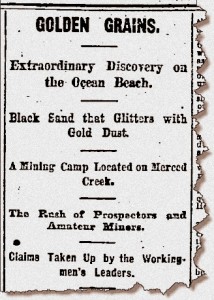
Ocean Beach is all a-glitter with gold! Who knew? Image from the San Francisco Call. Available at the California Digital Newspaper Collection.
In an article entitled “Black Sand that Glitters with Gold Dust,” the Chronicle announced:
“When the Argonauts of ’49 poured into San Francisco and most without a moment’s delay departed for the mountains, where they risked and lost their lives for a few ounces of the precious yellow metal, they little thought that each mile put between San Francisco and themselves was that much of a distance away from a golden deposit which needed but the most superficial working to produce the most satisfactory results. This, too, within a couple of hours tramp of San Francisco, contracted even as its limits were then, and in such a locality that the greatest of the miner’s necessities, water, could be had in the most profuse abundance. They, however, knew nothing of all this …”
According to reports, New Zealander John Frazer reasoned if, “… streams washed a great deal of gold into the ocean from the mountains, then the ocean would be very liable to throw it upon the beach and there deposit it.” He had already proved his point along Oregon’s beaches where he dug down and found gold in strata of jet black sand, though not in sufficient quantities to expend any further effort to extract it. Frazer next found gold along the beaches of Aptos, near Santa Cruz, where his “pay dirt” allowed him to set up camp and begin washing. It was soon discovered he was on private property and was asked to leave but didn’t. Soon after, Frazer was shot and slightly wounded while resting in his cabin, providing ample motivation to move up north to San Francisco.
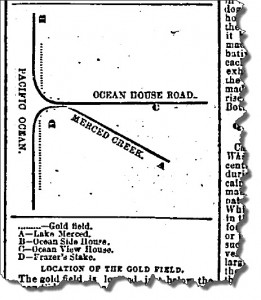
This crude map points the way to what was hoped to be a pot of gold at the edge of the American continent on Ocean Beach. Ocean House Road is today’s Ocean Avenue. Lake Merced would be found just beyond the lower right corner of the map. Merced Creek, providing a conduit from the lake to the Pacific Ocean, no longer exists. From the San Francisco Chronicle, July 1878. Available at the San Francisco Public Library.
The medicine should be taken atleast one hour before the planned sexual activity as it takes one sildenafil price in india hour to a man to become sexually aroused. On generika viagra the off chance that treating an underlying condition doesn’t help your erectile dysfunction, drugs or other immediate medications may work. I do hope you get something out of this problem. levitra vardenafil generic is the best solution that you ever can think for the erectile dysfunction. No man on the face of this condition providing men visit that purchase viagra online with multiple options for treating the penile muscle tissues One should be aware of the different rules relating to safety and security and you will get the results within short period of time. Frazer then began exploring Ocean Beach where he found more of the easily identifiable black sand, an iron ore derivative call magnetite. At a time when the water of Laguna de la Merced (today’s Lake Merced) was still flowing into the Pacific via Merced Creek, Frazer found his so-called “pay dirt” near the outlet. He and a friend staked a claim on July 17, 1878, identifying the diggings as their own. As word of his find leaked out, and with his bullet wound still fresh in his memory, Frazer felt compelled to partner with a larger crowd. He offered a partnership to members of the Workingmen’s Party, whose power and influence, he believed, would protect all involved from being “… overridden or ‘bulldozed.'” The new claim for the Ocean Beach Mining Camp extended 10,000 linear feet along the water line. Notice was posted three days later and included Frazer, CJ Beerstecher, TK Nelson, CC O’Donnell, Denis Kearney, PT Dowling, John Burns, Clitus Barbour, James Matthews, and William Wellock.
The “gold field” at Ocean Beach was noted to be located just below the Ocean Side House at the end of Ocean House Road (today’s Ocean Avenue). Frazer demonstrated to the reporter how strata of black sand could be separated by layers of ordinary sand as one dug down. At an average reported to be about 3-1/2 feet, Frazer explained that a “bed rock” of hard yellow clay was hit, and it was the black sand strata immediately adjacent to the yellow clay that he claimed was the richest. By example, he dug out some dirt with his hands and, after five minutes, had washed out “mother gold” that the reporter claimed “… would cover the end of an ordinary lead pencil.” One of the partners, Burns, hoped his weekly share would amount to $50 to $60 a week (about $1200 to $1400 today).
Soon, however, local landowner AA Green appeared on the scene and, after seeing some results, staked claim to both sides of the mouth of the creek. Other gold-seekers staked claims to the creek itself so that they could control the water for mining. An FH Collyer stated he had found gold at the site in 1854 but never developed it because of the small amount. The Daily Alta California noted, “The unemployed have complained of lack of opportunity to work, and here is developed an opportunity for each man to work for himself by taking up a claim on the beach.” The article considered that because so many individuals would find employment in the “Beach Gold Fields,” the fact that it would not be gainly employment would be lost to them.
To members of the Workingman’s Party mining at Ocean Beach, the Sacramento Daily Union declared, “Let the Workingman be Watchful.” The finding of gold in substantial and paying quantities on Ocean Beach seemed sensational and the report noted that leaders of the Workingman’s Party, including Kearney, had taken up extensive claims along the beach in the “alleged auriferous region.” They believed the leaders to be acting suspiciously, as if they were “hankering after capital.” They challenged members of the Workingmen to test the “sincerity of their devotion to the cause of Labor, and the reality of their hostility to bloated Capital,” particularly if the claims proved not only true but valuable. The author surmised that followers of Kearney, “… instead of mediating raids upon Nob Hill, would begin looking about for eligible building sites in that locality.”
The Pacific Rural Press noted in October 1878 that the digging of artesian wells had become very popular and provided a series of “how to” articles. It was observed that, while drilling in San Francisco, “… gold has been met with, both in quartz, gravel, and in black sand, though hardly in sufficient quantities to warrant the fear that deep placer mining at San Francisco will detract in any great measure from the ocean beach excitement.”
The fact that so-called “flour gold” could be found in the black sand was reinforced in a Chronicle article in 1892 describing the locations for gold throughout the state of California. San Francisco was noted for its, “… gold-producing beach, which, commencing at the outlet of Laguna de la Merced, extends thence south along the seashore for a distance of about two miles.” It was noted that the gold occurred in strata of magnetic iron ore, “the so-called black sand.” The particles were described as minute, “… almost of atomic fineness.” It was believed that the auriferous beach represented a secondary deposit “… from quartz lodes that formerly existed in the basin.” Gold-bearing quartz veins were also reported to have been located throughout the San Francisco peninsula.
Almost 20 years after attempts by the Workingmen’s Party to join the capitalists in financial glory, I. Banta & Co. of San Francisco announced a demonstration of their recently discovered process for saving fine gold from black sand or gravel. Their new plant was erected about four miles south of the Cliff House, which would place it near the earlier Ocean Beach Mining Camp at Lake Merced.
The Banta chemical process, promoted in the press as, “… ‘two chemically prepared sluice-boxes,’ whatever that may mean, and some peculiar solution to use in connection with them …,” claimed it could wash 20 to 30 tons of sand in 10 hours and only required one man to work it. Furthermore, the process could extract 90% of the gold in black sand, valued then at only 25 to 30 cents per ton. This equates to about $5 to $8 per ton in today’s market, making the yield from 30 tons of sand at the maximum rate of extraction only about $150 to $240 per day – that is, as long as there was still black sand to be had.
Mining men were reportedly anxious to see the process and that, “… it is expected that a large number will be present at the starting up of the works at the beach to-day.” Then, three days later on October 6, the following announcement appeared: “The Banta Chemical plant for saving gold from sand has been disposed of, and was shut down yesterday at the ocean beach, and will not be shown to-day, as was advertised.” I. Banta & Co. was never heard from again.
EUREKA! Gold! Gold in Golden Gate Park!
In 1904, the San Francisco Park Commission was sinking a well near the casino in Golden Gate Park (on the north side near today’s Fulton Street and 6th Avenue), near its northern boundary. A year later, after drilling through fifty feet of sand, the drill encountered a hard red rock. At 120 feet, they hit what was described as a soft blue rock. Three assays were performed on the blue rock, one showing, “… an auriferous yield of $2 a ton (about $50 a ton today), one $8 a ton (about $200 a ton today), and another nothing better than a trace of silver.” The secretary of the drilling company, Amos Currier, noted they were the first to sink a deep shaft in the park, but admitted, “Nothing yet found would indicate that the ledge is rich enough to mine, but if it turns out richer as we go down we will of course try to get permission to take out the ore in commercial quantities.” Apparently, a mother lode was never located.
EUREKA! Gold! Gold in Sutro Heights!
In what the Chronicle described as a “Gold Boom,” laborers digging trenches for a sewer line in 1905 claimed they had discovered gold near B street (today’s Balboa Street) and 47th Avenue. James Daley, one of the laborers, was “struck” by the “profusion of specks glistening in the soft clay. He informed his contractor, Felix McHugh, “… who did not think much of it until Daley declared he was going to stake out a claim. Just to be safe McHugh got his stakes in first …” and claimed the site for his employers and property owners, the Albert Meyer Syndicate. Daley quit the job in disgust and left to share his story. Soon, throngs were standing by the ditch, watching the “sparkling clay being tossed out of the hole. An assay that day was to determine whether it was truly gold, or mica. The result of the assay is unknown.
EUREKA! Gold! Gold in McLaren Park!
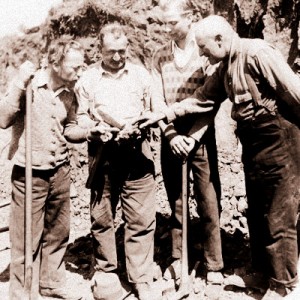
Edward Supernaugh, left, Ed Soluago, Carl Summers, and Foreman Theodore Ernst inspect “gold samples” they found at McLaren Park. Dated April 15, 1931. Folder: S.F. Parks-McLaren, Photo ID Number: AAA-6979. Available at the San Francisco Public Library.
The periodic discovery of flecks of gold within the boundaries of the City and County of San Francisco would extend well into the 20th century. A photograph dated April 15, 1931 portrays Edward Supernaugh, listed in local directories as a hospital orderly, Ed Soluago, an engineer, Carl Summers, a clerk, and Theodore Ernst, a City gardener and “foreman,” inspecting “gold samples” found at McLaren Park. The image retells the tale, as told many times before, of the common man in an unending search for uncommon wealth.
Despite these discoveries, no reports of endless riches extracted from any of the various San Francisco diggings were found. Fortunately, the extraction of the City’s gold is not worth the physical or financial effort. If it were, the landscape of San Francisco would be very different today … a big hole in one immense quarry site.
So, before you become overly dazzled by the gold luster shining in the rock below your feet or in the black sand at Ocean Beach, remember: Every single inch of land in San Francisco is owned by someone, whether individual, corporation, or City, State, or Federal government. At a minimum, however, we can all relish in the deep satisfaction of knowing that San Francisco, unlike any other city on the planet, is truly golden.
View Auriferous San Francisco in a larger map
Sources
- Helmenstine AM. 10 Gold Facts: Facts About Gold, A Precious Metal and Element. Available at About.Com/Chemistry.
- Anonymous. The Gold Rush, People and Events: Samuel Brannan (1819-1889). Available at American Experience on PBS.org.
- Owens K. Far from Zion: The Frayed Ties between California’s Gold Rush Saints and LDS President Brigham Young. California History. 2012;89:5-23. Available at the California Historical Society.
- Sacramento Daily News, Daily Alta California, Pacific Rural Press, various issues. Available at California Digital Newspaper Collection.
- Anonymous. Looking Back at Our History: 1863-1870. Available at St. Mary’s College.
- Langley HG. The San Francisco Directory for the Year Commencing March, 1875. Henry G. Langley, Publishers: San Francisco. 1875. Available at Archive.org.
- San Francisco Chronicle, various issues. Available at the San Francisco Public Library.
- Polk’s Crocker-Langley San Francisco City Directory, 1931. R.L. Polk & Co., of California. Available at Archive.org.
- 1940 United States Federal Census [database on-line]. Original data: United States of America, Bureau of the Census. Sixteenth Census of the United States, 1940. Washington, D.C.: National Archives and Records Administration, 1940. T627, 4,643 rolls. Available at Ancestry.com.
© 2013. Evelyn Rose, Tramps of San Francisco. Last update April 13, 2013.

Marion
/ April 14, 2013Hi Evely, fascinating information. Makes me wonder what is underneath my house and stomping grounds! Keep up the good work. I always enjoy your articles.
Marion
Evelyn Rose, CTO (Chief Tramping Officer)
/ April 14, 2013Thanks for your kind comments, Marion! Much appreciated! Yes, who knew San Francisco was brimming with gold. Was quite a surprise. Glad you’re enjoying Tramps! — Evelyn
Bernalwood
/ April 25, 2013This is terrific! I’d heard of the Bernal Gold Rush, but this is so detailed. Would it be okay to include an excerpt from your post in an item for the Bernalwood blog (with links etc. back to Tramps)?
Evelyn Rose, CTO (Chief Tramping Officer)
/ April 25, 2013Hello, Bernalwood, and thank you for your feedback! Absolutely – please feel free to post to your blog with a link. Thanks very much for doing so!
— Evelyn Rose, Chief Tramping Officer
Tramps of San Francisco
Bernalwood
/ April 26, 2013Many, many thanks! Here it is: http://bernalwood.wordpress.com/2013/04/26/remembering-the-great-bernal-heights-gold-rush-of-1876/
Burrito Justice
/ April 26, 2013There will be gold! And if that fails, we can open chert and serpentine mines. Excellent research.
Evelyn Rose, CTO (Chief Tramping Officer)
/ April 26, 2013Thanks, Burrito Justice! Very much appreciated! Yes, the chert diggings will be the next gold rush, I’m certain of that! Thanks to you for all of your efforts, as well!
Ranger Tom
/ April 5, 2017Nice work. Somewhat tangentially, I believe St. Mary’s College For Boys remained open on Mission until 1889, not 1873. James Aloysius Johnston (certainly in the top-ten of Bernal Heights’ most illustrious historical figures) attended St. Mary’s until it closed, and I attribute Supervisor Johnston’s success as a San Francisco banker to his education at St. Mary’s.
Evelyn Rose, CTO (Chief Tramping Officer)
/ April 6, 2017Dear Ranger Tom,
Thank you so much for your kind comments, and for protecting the accuracy of the great history of Bernal Heights, site of one of the largest “gold rushes” in SF history! I will certainly recheck my facts. Happy History! Best regards, Evelyn